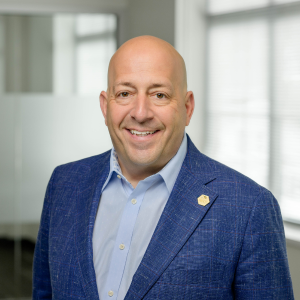Cooking and Conversation: How an Open-Kitchen Culture Fosters Meaningful Relationships with Residents
In many senior care communities, meals are prepared behind-the-scenes, with kitchens tucked away from dining areas. This means chefs rarely see immediate reactions to their dishes or hear direct feedback. At Sage Oak of Denton, a boutique assisted living and memory care community, that tradition is being reimagined with an open-kitchen approach, as Chef Larry Atwater sparks conversations and connections with residents as he cooks.
Read on to discover how Sage Oak’s open-kitchen culture transforms mealtime into a space for real-time conversation, personalized dining, and meaningful connections – and how other senior care communities can apply these lessons to elevate resident engagement and dining experiences.
How an Open-Kitchen Culture Fosters Conversation

Chef Larry Atwater, Sage Oak of Denton
Atwater notes that the open layout between the kitchen and dining room invites residents to interact with him, allowing conversations to flow naturally. “They come sit around the bar, and sometimes they’ll come up adjacent to the line,” he says. “The chefs are not only there to cook, but to engage with the residents as well.”
The open-kitchen concept is a significant change from previous senior living settings where Atwater has worked. In those settings, he was behind a firewall in the back corner of the building, so speaking with residents wasn’t possible.
“I think as we introduced this open kitchen model to Chef Atwater, where there’s no barrier between him and the clients, the model prompted him to change how he was engaging with the client,” explains Loe Hornbuckle, founder and CEO of Sage Oak.
The Value of Real-Time Conversation
Being able to converse with residents while preparing meals offers numerous benefits for both the residents and for Atwater and his team. “We like to say we get instant feedback from residents, pan to plate,” says Atwater. “We know if they’re enjoying the food or not.” The conversations allow Atwater to revamp the menu and to make personalized touches on the plates as well as on the menu, and he can quickly make changes to ensure the meals are well-received.
Atwater previously worked in a senior care community that had about 400 residents. Because the kitchen was separated from the dining room, he didn’t receive feedback on meals until about a month later, giving him little information to base his menu creation on. “Here, I get to talk and interact, and we’re able to cater each menu,” he explains.
Sage Oak’s house structure also allows for extra menu personalization. With only 16 residents in each house, Atwater can easily learn their preferences and design menus that reflect them. For example, one house might like fish or Louisianan-style food. Atwater can adapt his menus to ensure they reflect the types of meals each house’s residents enjoy most.
The conversations are rewarding, too. “Here, everything is a personal connection, not only with residents, but family members,” he explains. “I know every resident by their first name. Everybody’s on a hug basis.”
Hiring for the Open-Kitchen Concept

Loe Hornbuckle, founder and CEO of Sage Oak
While the open-kitchen concept offers many benefits, it also requires staff with the right skills and personalities to succeed. Hornbuckle notes that when Sage Oak hired Atwater and other kitchen staff, the focus shifted beyond technical ability to include the performative side of meal preparation. “When we bring people in, we explain it like they’re a private chef cooking at a dinner party,” says Hornbuckle.
Today, the organization looks for chefs who not only bring strong culinary skills and safe food practices but also the personality to engage residents in the open-kitchen setting. Restaurant kitchens tend to be more chaotic than diners might realize, because they’re separated from the space. “When the kitchen is open, there’s no place for that,” Hornbuckle explains.
Sage Oak has concentrated on hiring dining staff for roles that interact with residents, while eliminating those that do not. “The performative aspects, the visiting, the talking, and if the residents are having fun with you – you remember food that’s an experience,” says Hornbuckle. Residents receive that experience with every meal at Sage Oak.
Strategies to Help Dining Staff Connect with Residents
While some senior care communities may not have open kitchens, dining staff can still find meaningful ways to connect with residents. “Thinking in hindsight, I would encourage chefs to do more table touches, go out and meet residents, try to meet family residents, and try to keep that dialogue going,” Atwater recommends. Because each person’s relationship with food is different, it’s important to learn what each resident likes and dislikes and understand what motivates them.
Hornbuckle notes that just about everyone working in senior living does so for a personal reason, and it’s often connected to serviing others. Creating an environment where chefs can engage with residents affirms their commitment to serving others. “In traditional senior living, theoretically you could be cooking for anyone,” says Hornbuckle. “At Sage Oak, you’re cooking for residents right in front of you.”
Most importantly, chefs can find ways to develop meaningful relationships with residents, making their work more rewarding and helping residents feel seen and heard. “Everyone has a family member who’s actively aging. Treat them as you would their family member,” advises Atwater. “I look at all of my residents as members of my family.”

Paige Cerulli is a contributing writer to i Advance Senior Care.
Related Articles
Topics: Communication , Design , Facility management , Featured Articles , Nutrition , Operations












